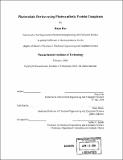| dc.contributor.advisor | Marc Baldo. | en_US |
| dc.contributor.author | Das, Rupa, 1980- | en_US |
| dc.contributor.other | Massachusetts Institute of Technology. Dept. of Electrical Engineering and Computer Science. | en_US |
| dc.date.accessioned | 2006-03-24T18:19:36Z | |
| dc.date.available | 2006-03-24T18:19:36Z | |
| dc.date.copyright | 2004 | en_US |
| dc.date.issued | 2004 | en_US |
| dc.identifier.uri | http://hdl.handle.net/1721.1/30101 | |
| dc.description | Thesis (S.M.)--Massachusetts Institute of Technology, Dept. of Electrical Engineering and Computer Science, 2004. | en_US |
| dc.description | Includes bibliographical references (leaves 59-63). | en_US |
| dc.description.abstract | Photosynthetic proteins have been used as an active material in design of organic solar cells. Traditional organic solar cells have the limitation of not being able to absorb light in the visible-NIR region of the solar spectrum. This region corresponds to over 70% power of the total solar radiation. Using molecular proteins obtained from nature these limitations can be overcome. Biological photosynthetic complexes contain reaction centers with a quantum yield of >95% and a bandgap of less than l.leV allowing absorption in the 600-11 00nm visible-NIR range. Two types of photosynthetic complexes are employed to demonstrate the generality of the solid state integration technique to make solar cells. The simplest photosynthetic complex used is a bacterial reaction center (RC), isolated from the purple bacterium R. sphaeroides. The other protein being used is Photosystem I (PSI), a much larger complex, which is isolated from spinach chloroplasts. Electronic integration of devices is achieved by depositing organic semiconducting protective layer over a self-assembled monolayer of photosynthetic reaction centers oriented via an engineered metal-affinity polyhistidine tag. Various analytical and spectroscopic techniques have been used to examine solution spectrum and solid state device characteristics. Reasonable efficiencies have been obtained which demonstrates applicability of such techniques. The efficiency obtained is higher than a wet cell made using same proteins. The next immediate goal is to optimize processing conditions and therefore improve efficiency to reach levels comparable traditional organic solar cells. | en_US |
| dc.description.statementofresponsibility | by Rupa Das. | en_US |
| dc.format.extent | 63 leaves | en_US |
| dc.format.extent | 2334411 bytes | |
| dc.format.extent | 2334219 bytes | |
| dc.format.mimetype | application/pdf | |
| dc.format.mimetype | application/pdf | |
| dc.language.iso | eng | en_US |
| dc.publisher | Massachusetts Institute of Technology | en_US |
| dc.rights | M.I.T. theses are protected by copyright. They may be viewed from this source for any purpose, but reproduction or distribution in any format is prohibited without written permission. See provided URL for inquiries about permission. | en_US |
| dc.rights.uri | http://dspace.mit.edu/handle/1721.1/7582 | |
| dc.subject | Electrical Engineering and Computer Science. | en_US |
| dc.title | Photovoltaic devices using photosynthetic protein complexes | en_US |
| dc.type | Thesis | en_US |
| dc.description.degree | S.M. | en_US |
| dc.contributor.department | Massachusetts Institute of Technology. Department of Electrical Engineering and Computer Science | |
| dc.identifier.oclc | 55693540 | en_US |
